How wide-angle macro photography can help you capture close-ups with impact (part 1 of a series)
posted Tuesday, July 16, 2013 at 5:17 PM EDT
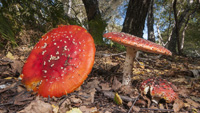
Macro shots have tremendous photographic appeal as they get us up-close-and-personal with a wide variety of subjects, be they insects or flowers or intricate details of much larger objects. But what if there was a way of using non-macro, non-telephoto lenses to accomplish this task? What if you could capture up-close images with great impact that not only show your primary subject to advantage -- but also give background context to it, telling the full story?
Well, this approach is something I specialize in. Some people call it wide-angle macro. And I want to show you how wide-angle lenses -- both primes and zooms -- can help you explore vistas you may not have realized these lenses can capture.
The time-tested advice for achieving better wide-angle shots has always been to include "foreground interest" such as rocks, trees or flowers to lead the eye of the viewer into the frame. For even greater impact, you can set the camera in a low position for a change in perspective that emphasizes the subject dramatically.
Personally, I like to turn that advice on its head a bit -- contrariness is a way of life for me. I believe the trick for successful wide-angle close-ups is to let that foreground interest dominate and move in as close as your lens will allow. The background becomes secondary but tells you a lot about where and how a subject lives and your picture suddenly becomes much more informative.
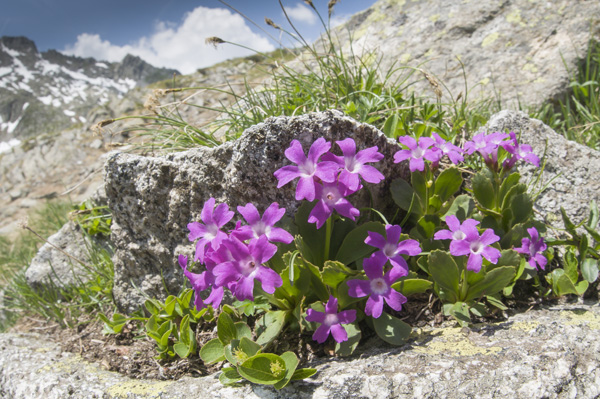
The foreground interest is the point of the picture rather than the landscape, not vice versa with these pink primulas in the Dolomites (northern Italy).
Photo by Paul Harcourt Davies
How wide angle adds close-up impact
Wide-angle lenses can be particularly effectively to create close-ups with impact. After all, the wider the angle of view and shorter the focal length, the greater the distortion of perspective you can create to exaggerate the parts of a subject closest to the lens.
This close and wide approach is great for many subjects -- take flowers, for example.
Flowers are the part of a plant we usually notice first. They're colorful and stand out (to our eyes, at least) against dark leaves, serving as beacons that attract bees, butterflies and other bugs for pollination purposes. The perspective distortion that comes with using ultra-wide lenses up close exaggerates flowers set in the foreground as we move from the three dimensions of reality to the two dimensions of an image. I believe it creates heightened visual interest because it mirrors the way we registered those flowers in the first place: We notice the flowers first and then take in where they are situated.
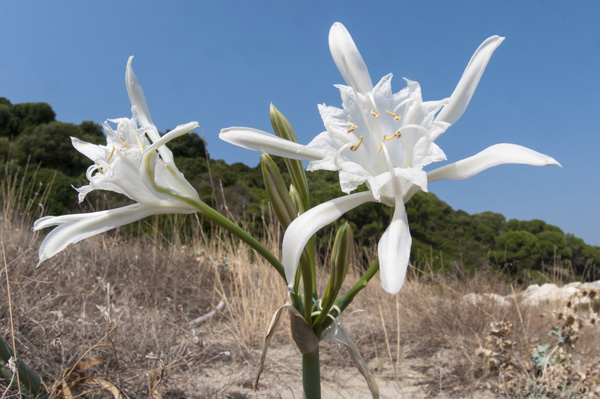
The perspective distortion of ultra-wide lenses brings immediate attention to a subject at close quarters, giving increased impact to your shots. These are sand lilies on the island of Sardinia.
Photo by Paul Harcourt Davies
So how do you go about shooting wide-angle macro? It all begins with using the right lenses.
Lenses for wide-angle macro
You don't need to use any special wide-angle macro lens for this type of photography. In fact, any wide-angle zoom or prime will work to a greater or lesser degree -- even those that come equipped on compact digital cameras. Some lenses, of course, will function better than others simply because they're better, sharper lenses.
What lenses and focal lengths work best? Well, given the wide choice of fixed-focal-length lenses, zooms and rectangular fisheyes, the answer may well lie with the wide-angle primes you may have consigned to the bottom of your camera bag.
Yes, it's time to dig out your 20mm, 24mm, 28mm and 35mm lenses -- any of these should suffice.
The most important factor of the lens you choose is the distance of closest focus -- this is usually quoted as the distance from the sensor plane to the subject. You can find out from the lens specs how close this will be to the front element of the lens by subtracting the length of the lens. If you don't have access to the specs, you can simply test this out in the field by trial and error. Ideally, you want the minimum focus distance to be less than 30cm (about 12 inches).
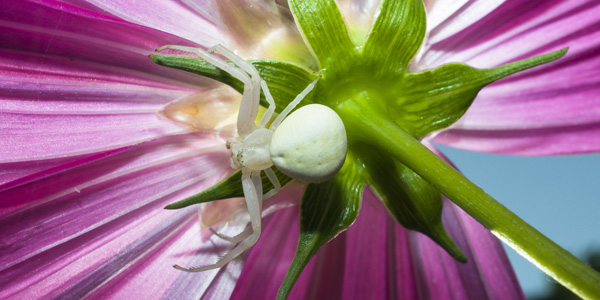
A crab spider hides behind a flower at the close-focus limit of my venerable 28mm Nikkor -- just 20cm from the sensor. Cropping the picture aspect to 2:1 accentuates the wide feel.
Photo by Paul Harcourt Davies
Primes vs. zooms
Primes tend to be much better than zooms, and their manual focusing versions best of all in this respect. With manual lenses it's simply a matter of incorporating a longer thread length, a solely mechanical aspect of the lens mount that allows you to get closer to your subject.
But that's not to say that zooms can't be used. After all, many photographers now get their experience of different focal lengths of lens via a zoom as a first purchase or kit lens. But I wouldn't recommend a zoom with much range. Typically lenses such as an 18-55mm or especially an 18-200mm won't perform as well for the wide-angle macro task. Since they're designed for a wide range of purposes, they feature compromises in design -- one of them usually being a minimum focus distance that is much farther than ideal.
For this reason, the best zooms for wide-angle macro tend to be those with a max zoom range of 2x, such as a 10-20mm,14-24mm,16-35mm or similar. Unfortunately, they inevitably cost a great deal more than the kit zooms because the design and construction are a great deal more complex.
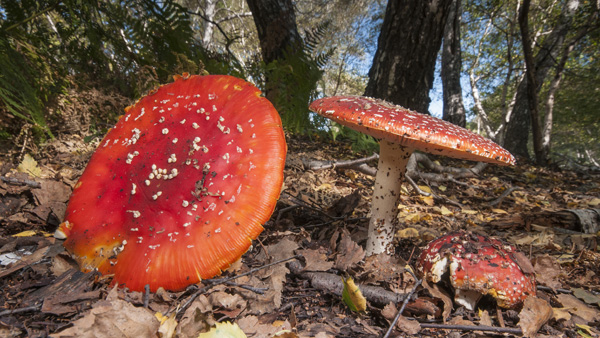
Wide angle zooms with a range of no more than 2x offer some of the best close-focus distances. Here a Sigma 10-20mm (at 12mm) captures the Fly Agaric mushrooms (a 2:1 crop again emphasizes the wide approach).
Photo by Paul Harcourt Davies
What about fixed-focal-length lenses with autofocus? A few will take you in close but this does not seem to have been made a priority by many manufacturers these days. I've found, however, that Sigma seems to be in tune with the needs of close-up and macro enthusiasts. They produce 20mm, 24mm and 28mm AF lenses that are extremely sharp, offer a maximum f/1.8 aperture (in fact, wider than you need for wide-angle macro) and focus closer than most as the table below shows.
|
Sigma Wide Angle Lens |
Closest Focus |
Max Magnification & Reproduction Ratio |
|
20mm f/1.8 EX DG Aspherical |
0.20m |
0.25 x (1:4) |
|
24mm f/1.8 EX DG Aspherical |
0.18m |
0.37 x (1:2.7) |
|
28mm f/1.8 EX DG Aspherical |
0.20m |
0.34x (1:2.9) |
Getting even closer with extension tubes
There's a way to get closer to your macro subject (with a more magnified image) than the internal thread on a lens allows: an extension tube. An extension tube is basically a metal ring that lets you increase the separation between an interchangeable lens and the camera's sensor. As you move the lens away from the sensor, light rays spread out to give a larger image circle. If you imagine the sensor at the center of this circle, it covers a smaller portion of the image and so the image appears magnified.
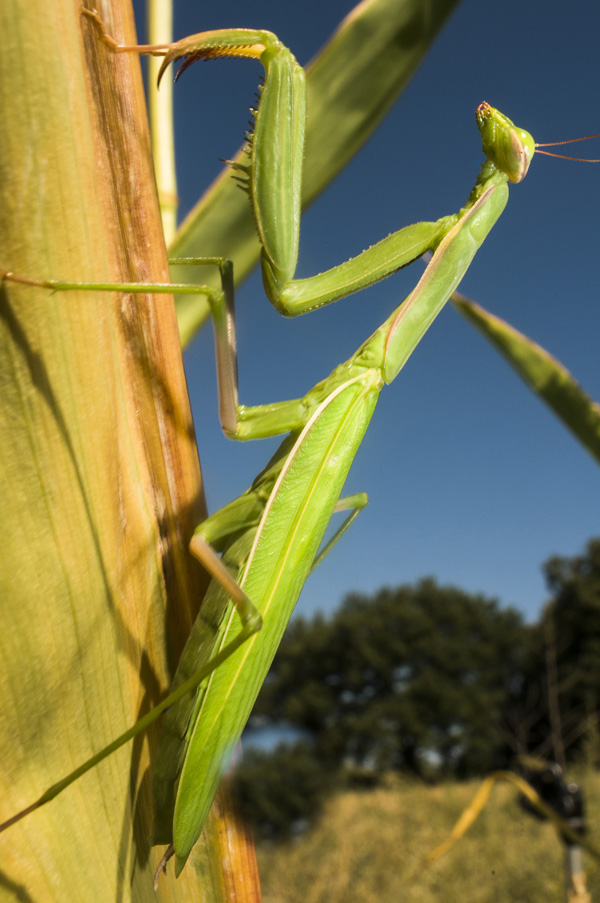
Still going strong after nearly three decades, my Nikkor 28mm f/2.8 AIS used with a single 8mm extension tube just filled the frame with an evening shot of this praying mantis.
Photo by Paul Harcourt Davies
Commercial extension tubes have a lens mount at one end and camera mount at the other -- the simplest ones cost a few dollars online. However, those that offer coupling of metering (and even) autofocus between lens and camera are costly items of precision engineering. They are made by a handful of camera manufacturers and by Kenko.
Using extension tubes can be an ideal way to get greater magnification with a wide-angle lens and the pictures can be extremely dramatic. However, the thinnest or narrowest extension tubes often produce an extension of 10-12mm, and with an ultra-wide lens this gets you very close to the subject -- perhaps too close.
Here are a couple factors to consider about using extension tubes:
- 'Thin' (or narrow) extension tubes are few and far between. Canon once made a manual 5mm tube for their FD lenses and Nikon's thinnest, the PK11A, gives 8mm of extension, but offers only manual coupling
- With a 20mm lens, even a small extension means you are almost touching the subject, which can cause lighting problems with the shadow you and the lens cast and, most important, scaring off insect and animal subjects.
For those who like using their calculators, you can easily work out the magnification an extension tube produces by using this formula:
M (magnification) = d (added length of tube) / f (focal length)
In other words, the smaller the focal length of a lens the bigger the effect an extension tube has. As an example, an extension tube of 8mm used with a 20mm lens produces a magnification of 8/20 or 0.4x (which is 1:2.5).
This formula works for the lens set on the infinity mark -- you'll get a bit more magnification than this from the internal extension provided by the focus mechanism.
So, any camera body (even a high-end point-and-shoot!) paired with a wide-angle lens is all you need to start capturing some wide-angle macro images. Don't worry about going out and buying new equipment to achieve the task at first; use the best options you already have available. Any limitations you come across can be solved later. The important thing is to get out there and see what your equipment -- and your imagination -- can capture.
Paul Harcourt Davies is a long-time professional photographer, and an author of 19 books with a background that fuses technical and artistic elements to his life-long passion for photography of the natural world. We reviewed his e-book (that he co-wrote with frequent collaborator Clay Bolt): Wide-Angle Macro: The Essential Guide a few months ago, and we knew we wanted to share more of his insights and amazing images with our readers. (You can order a copy of the book here.) An experimenter and innovator by nature, he has long been on a mission through his writing and lectures to bring the techniques of macro photography to others. For the last 10 years he has been based in Umbria, central Italy, renovating an old farmhouse with a wild garden from where he organizes tours, workshops and much else.
Read Part 2 of our Wide-Angle Macro Photography series for tips and tricks including positioning, depth of field and more.
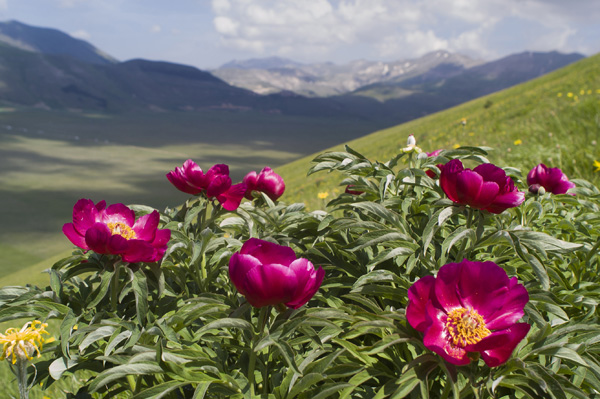
Wild Peonies in the foreground add drama to the landscape of Sibillini, Italy.
Photo by Paul Harcourt Davies